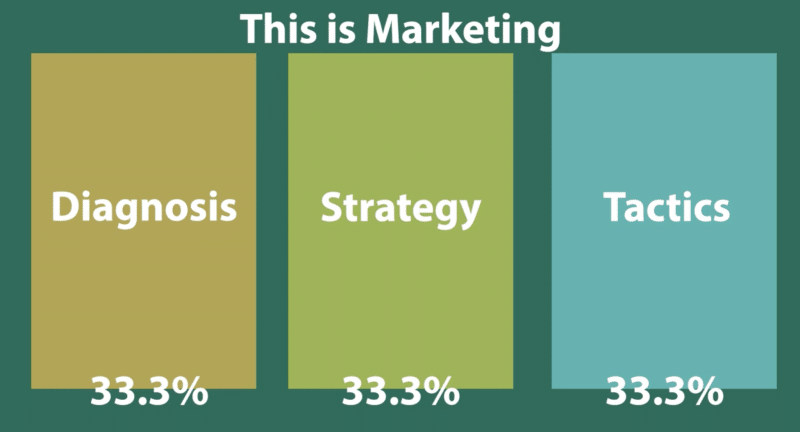When last I mused… I realized I left something hanging…
Unfortunately, those fundamentals aren’t apparent. Ask 4 marketers the same question, and you’ll get 7 different answers. Pilots, architects, orchestra conductors, and drivers on the road all agree on the fundamentals. We marketers struggle with that. Sorry.
Watch this article with movin’ pictures in about 6 mins
The fundamentals in marketing are explained brilliantly by Professor Mark Ritson who brought his Ph.D. in Marketing to Marketing Week’s MiniMBA course. He breaks it down into 3 logical parts:
“First, we diagnose what’s going on. Second, we develop a strategy. Strategy has got nothing to do with tactics. Nothing. It’s cold and it’s blue and it’s been the same for more than 2000 years. And then finally, the tactics deliver on the strategy.” (From “What Does and Doesn’t Matter in Marketing”)
First we diagnose. When I do this, I’m trying to learn about a company at the cellular level. Where did it come from? Why does it exist? What kind of purchase cycle is the customer in? Is the company growing or stagnant? What are we trying to accomplish and how will we know when we get there? New brand, or established one? Innovating industry or stalwart? Market, product, or sales oriented? Luxury price or discount? This diagnosis goes on for days. Maybe weeks. Possibly months. It’s that important.
Strategy. You can only build a strategy if you’ve done a diagnosis. Strategy has nothing to do with tactics. So if you’re already tossing direct mail, SEO, and TV commercials, you’ve overshot the runway. Strategy is answering:
• Who are we talking to?
• What position will we take?
• How will we know we’ve done it?
Who are we talking to? We’re segmenting our customers into who they are, and who they are not. Coupon clippers or relational types? Early adopters or traditionalists? First class or coach? Plenty of ways to segment, but it’s gotta be done.
What position are we going to take? How is your brand going to be different from the 17 other brands in the same category? It has to live someplace in the customer’s mind… you gotta figure it out.
How will we know we’ve done it? Every plan has to have a goal. How will you know if you’ve moved your segmented audience and claimed a position? What will you measure and when?
Tactics. OK… now you can start to look at tactics. And while advertising is a tactic… it’s just one tactic.

Ritson continues: “What’s been happening is what I call ‘communification.’ I made that word up. What that means is we don’t bother with tactics anymore. And we just focus on communications. We don’t call it communications, we call it ‘content marketing’ and we call it ‘social and digital and tv.’ But the point is, it’s just comms. It’s a small part of marketing.”
Tactics include Price, Product, Place, and Promotion. The famous “4Ps of Marketing.”
Price is looking at the message a price sends, the competitiveness of the price, and the profit it sends back to the company.
Product is the product or service itself. Is it viable and scaleable? What are its features and benefits? Is it special?
Place refers to things like supply and distribution chain, location, and merchandising for retail companies.
Promotion, usually called “communication,” includes staff selling skills, logos, public relations and…advertising.
This means advertising is just a piece of communications…which is just one of the tactics…which is just 1/3 of Marketing.
Yes. The math is right. Advertising only accounts for about 8% of Marketing.
If all you’re talking about is Advertising, you’re missing over 90% of the stuff that matters.
“Now here’s the key point. They’re multiplicative. This is why brand management’s so hard. If you f— up one of the three, you’re f—–. Okay? That’s Latin. If you get one of them wrong, the whole thing’s wrong. And that makes marketing hard. It’s multiplicative. You can’t make up for a shit diagnosis with a really good strategy cuz your strategy’s built from your diagnosis. So they all weight approximately the same.” (From Mark Ritson, “On the Contrary,” APG Strategy Conference 2018)
This is the stuff that does not change. Marketing is still the same job it’s been and the same rules apply. Marketing has not changed and there’s no reason to think it will change. Pieces and parts of advertising have changed. Whether it’s the back cover of a comic book or a zany TikTok dance is irrelevant. That’s just advertising.
The marketing fundamentals behind those ads matter much much more. And the fundamentals remain the same.
- Marketing Has a Physics Problem - December 3, 2025
- AI is OK - August 14, 2025
- Emotion in Advertising Equals Dollars in Business - December 3, 2024
